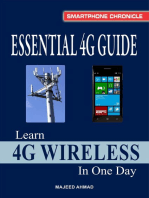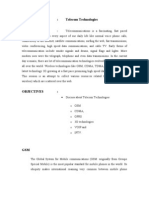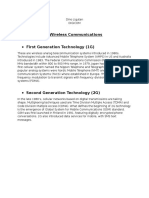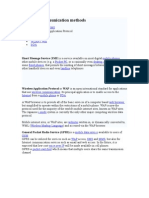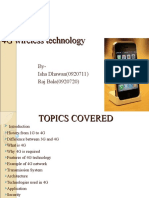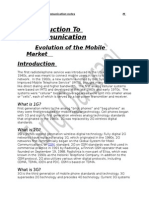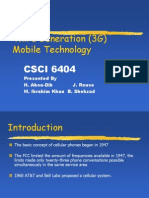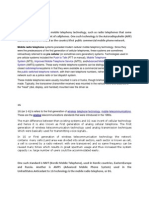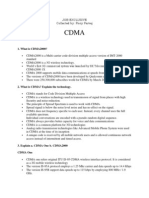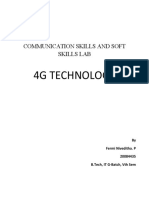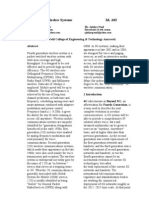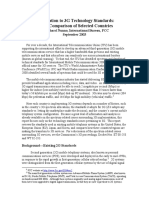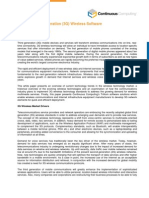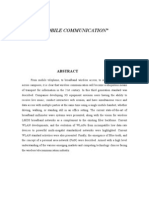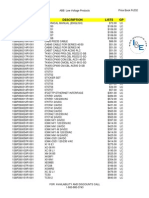State of The Art of Modulation Techniques Being Used in Various Communication Technologies
State of The Art of Modulation Techniques Being Used in Various Communication Technologies
Uploaded by
Sabbir AhmedCopyright:
Available Formats
State of The Art of Modulation Techniques Being Used in Various Communication Technologies
State of The Art of Modulation Techniques Being Used in Various Communication Technologies
Uploaded by
Sabbir AhmedOriginal Description:
Original Title
Copyright
Available Formats
Share this document
Did you find this document useful?
Is this content inappropriate?
Copyright:
Available Formats
State of The Art of Modulation Techniques Being Used in Various Communication Technologies
State of The Art of Modulation Techniques Being Used in Various Communication Technologies
Uploaded by
Sabbir AhmedCopyright:
Available Formats
State of the art of modulation techniques being used in various communication
technologies: GSM (both 2G, 3G and HSPA), CDMA, WiMax and LTE
What is GSM? GSM is a TDMA based wireless network technology developed in Europe that is used
throughout most of the world. GSM phones make use of a SIM card to identify the user's account. The
use of the SIM card allows GSM network users to quickly move their phone number from one GSM
phone to another by simply moving the SIM card. Currently GSM networks operate on the 850MHz,
900MHz, 1800MHz, and 1900MHz frequency bands. Devices that support all four bands are called quad-
band, with those that support 3 or 2 bands called tri-band and dual-band, respectively. In the United
States, Cingular operates on the 850 and 1900MHz bands, while T-Mobile operates only on the
1900MHz band. Also known as: "Global System for Mobile Communications". GSM, or Global System for
Mobile Communications, is a cellular phone protocol that is standard in most parts of the world.
Technology experts created the protocol in the 1980s and '90s to standardize cellular phone service
between countries in Europe. GSM phones use subscriber identity module (SIM) cards, which is essential
to their function and enable the user to change phones easily. It is a chief competitor to the Code
Division Multiple Access (CDMA) protocol.
What is 2G Technology?
2G is short for Second Generation, the name usually given to original GSM, CDMA, and TDMA
networks. 1G, a term rarely used, would refer to the original analog (AMPS) type mobile
networks first used in the early 1980s.
Also known as: "second generation"
How 2G Technology Works?
The 2G technology or Second generation technology was launched in Finland in 1991.In
this article, we will focus on the working of 2g technologies and the technology of 2g.
The technology behind 2g is based on GSM or in other words global system for
communication. Read on to know how 2g technology works.
Depending on the type of multiplexing used, the 2G technologies are divided into
TDMA-based (time division multiple access) and CDMA-based standards (code division
multiple access). While the TDMA allows for the division of signal into time slots, the
CDMA on the other hand allocates each user a special code to communicate over a
multiplex physical channel. TDMA assigns each call a certain portion of time on a
designated frequency and the CDMA gives a unique code to each call, thus spreading it
over the available frequencies. The last part of each name, which is multiple access,
simply means that more than one user can make use of each cell.
How 3G Technology works?
The term 3G internet refers to the third generation of mobile phone standards, as set by the
International Telecommunications Union (ITU). 3G technologies allow mobile operators to offer
more service options to their users, including mobile broadband.3G broadband offers greater
flexibility and services by making more efficient use of mobile bandwidth than its predecessor
2G. And although faster, newer 4G technology is now available in the UK, 3G remains the UK's
dominant mobile broadband technology. The relationship between 2G and 3G is similar to that
of dial-up and broadband, or terrestrial TV and digital TV. In all of the latter examples, greater
spectral efficiency has enabled more consumer choice and a more effective service. Simply put,
more data can be transmitted faster.
3G or third-generation technology gives the ability to transfer both voice as well as non-voice
based Data at a much faster level. 3G-enabled devices includes phones and laptops that work by
sending and receiving radio signals to and from base stations. The base stations link individual
phones into the rest of the mobile and landline networks.
What is HSPA?
The term HSPA (High Speed Packet Access) is commonly used to refer to UMTS based 3G
networks that support both HSDPA and HSUPA data for improved download and upload speeds.
HSPA can also be used to refer to the entire family of related systems, which includes the
upcoming HSPA+.
Also known as: "High Speed Packet Access"
High Speed Packet Access (HSPA) is the most widely deployed mobile broadband technology in
the world today. HSPA is the terminology used when both HSDPA (3GPP Release 5) and
HSUPA (3GPP Release 6) technologies are deployed on a network. All UMTS and HSDPA
networks are expected to be upgraded to HSPA.
HSPA (high speed packet access) is a third-generation (3G) mobile broadband communications
technology.
What is HSPA or HSPA+ (4G)?
Mobile network technology is constantly being improved, primarily to let you send and receive
data faster.
HSPA (High Speed Packet Access) is a mobile telephony technology that allows for data
transmission speeds up to 21 Mbps. HSPA+ (also called Evolved HSPA or 4G) is a further
evolution of HSPA that offers data speeds of up to 42 Mbps.
Youll appreciate the speed if you use the Internet or applications like picture and video
messaging on your mobile phone or smartphone.
The HSPA+ (4G) network allows you to bring some mobile phones and smartphones to the Bell
network. 1XRTT and EVDO are slightly earlier network technologies. Bell uses all these
technologies in our networks, although different networks are available in different areas.
network lookup tool - find out which network your mobile phone or smartphone uses
Coverage maps - see which Bell network is in your area
What is CDMA?
CDMA, or Code Division Multiple Access, is a competing cell phone service technology to GSM,
which is the worlds most widely used cell phone standard. CDMA uses a spread-spectrum
technique whereby electromagnetic energy is spread to allow for a signal with a wider
bandwidth. This allows multiple people on multiple cell phones to be multiplexed over the
same channel to share a bandwidth of frequencies.
With CDMA technology, data and voice packets are separated using codes and then transmitted
using a wide frequency range. Since more space is often allocated for data with CDMA, this
standard became attractive for 3G high-speed mobile Internet use.
The CDMA standard was originally designed by Qualcomm in the U.S. and is primarily used in
the U.S. and portions of Asia by other carriers. Sprint, Virgin Mobile and Verizon Wireless use
CDMA while T-Mobile and AT&T use GSM.
While CDMA and GSM compete head on in terms of higher bandwidth speed (i.e. for surfing the
mobile Web), GSM has more complete global coverage due to roaming and international
roaming contracts.
GSM technology tends to cover rural areas in the U.S. more completely than CDMA. Over time,
CDMA won out over less advanced TDMA technology, which was incorporated into more
advanced GSM.
CDMA (Code Division Multiple Access) and GSM (Global System for Mobiles) are shorthand for the two
major radio systems used in cell phones. Both acronyms tend to group together a bunch of technologies
run by the same entities. In this story, I'll try to explain who uses which technology . CDMA (Code-
Division Multiple Access) is a channel access method used by various radio communication
technologies. It is a form of multiplexing, which allows numerous signals to occupy a single
transmission channel, optimizing the use of available bandwidth. The technology is used in ultra-
high-frequency (UHF) cellular telephone systems in the 800-MHz and 1.9-GHz bands.
CDMA employs analog-to-digital conversion (ADC) in combination with spread spectrum
technology. Audio input is first digitized into binary elements. The frequency of the transmitted
signal is then made to vary according to a defined pattern (code), so it can be intercepted only by
a receiver whose frequency response is programmed with the same code, so it follows exactly
along with the transmitter frequency. There are trillions of possible frequency-sequencing codes,
which enhances privacy and makes cloning difficult.
What is WIMAX?
WiMAX is a technology standard for long-range wireless networking. WiMAX equipment exists
in two basic forms - base stations, installed by service providers to deploy the technology in a
coverage area, and receivers, installed in clients. WiMAX supports several networking usage
models:
1. a means to transfer data across an Internet service provider network, commonly called
backhaul)
2. a form of fixed wireless broadband Internet access, replacing satellite Internet service
3. a form of mobile Internet access that at one time competed directly with LTE
technology
While at one time WiMAX was envisioned to be a leading form of Internet communications
across all three of the areas above, it's adoption has been limited.
WiMAX is developed by an industry consortium, overseen by a group called the WiMAX
Forum. The Forum certifies WiMAX equipment to ensure it meets the technology standards. Its
technology is based on the IEEE 802.16 set of wide-area communications standards. WiMAX
signals can function over a distance of several miles (kilometers) with data rates reaching up to
75 megabits per second (Mb/s). A number of wireless signaling options exist ranging anywhere
from the 2 GHz range up to 66 GHz.
Primarily due to its much higher cost, WiMAX is not a replacement for Wi-Fi home networking
or Wi-Fi hotspot technologies.
Also Known As: Worldwide Interoperability for Microwave Access
WiMAX is a wireless technology put forth by the WiMAX Forum that is one of the technologies
that is being used for 4G networks. It can be used in both point to point and the typical WAN
type configurations that are also used by 2G and 3G mobile network carriers. Its formal name is
IEEE standard 802.16. Sprint owns a WiMAX based network that is marketed under the name
XOHM, though that will eventually be merged with Clearwire's network and sold under the
Clearwire name. LTE is a competing technology that has the support of far more carriers
worldwide.
Also known as: "802.16"
What is LTE 2?
LTE supports deployment on different frequency bandwidths. The current specification outlines
the following bandwidth blocks: 1.4MHz, 3MHz, 5MHz, 10MHz, 15MHz, and 20MHz.
Frequency bandwidth blocks are essentially the amount of space a network operator dedicates to
a network. Depending on the type of LTE being deployed, these bandwidths have slightly
different meaning in terms of capacity. That will be covered later, though. An operator may
choose to deploy LTE in a smaller bandwidth and grow it to a larger one as it transitions
subscribers off of its legacy networks (GSM, CDMA, etc. Metro PCS is an example of a network
operator that has done this. A majority of its spectrum is still dedicated to CDMA, with 1.4MHz
or 3MHz dedicated for LTE depending on the market.
You might also like
- Essential 4G Guide: Learn 4G Wireless In One DayFrom EverandEssential 4G Guide: Learn 4G Wireless In One DayRating: 4.5 out of 5 stars4.5/5 (12)
- 3G 4GDocument24 pages3G 4Gsyed_engrNo ratings yet
- Session 21: Telecom TechnologiesDocument11 pagesSession 21: Telecom TechnologiesPrateek DagarNo ratings yet
- 4G and Its EvolutionDocument11 pages4G and Its EvolutionVamsee KrishnaNo ratings yet
- 4G TechnologyDocument28 pages4G Technologyarpit109100% (3)
- Wireless Communication TechnologiesDocument10 pagesWireless Communication TechnologiesDino LigutanNo ratings yet
- Different Communication Methods: Short Message Service (SMS) Is A Service Available On Most DigitalDocument6 pagesDifferent Communication Methods: Short Message Service (SMS) Is A Service Available On Most Digitalapi-26681123No ratings yet
- Access Methods For Mobile Networks - ShavaneDocument2 pagesAccess Methods For Mobile Networks - ShavaneDrumz Staff50% (2)
- Comparative Study of GSM, CDMA, 2G, 3G and 4 G Methods What Is GSM?Document14 pagesComparative Study of GSM, CDMA, 2G, 3G and 4 G Methods What Is GSM?Clean 91No ratings yet
- Ch1-Wireless (Generations and Types)Document46 pagesCh1-Wireless (Generations and Types)bereket.crowNo ratings yet
- QB1 QB2 QB3 MergedDocument11 pagesQB1 QB2 QB3 MergedHarsh KumarNo ratings yet
- Generations of Wireless Mobile Systems: Comparison of Channel Capacity For Different Channel TypesDocument2 pagesGenerations of Wireless Mobile Systems: Comparison of Channel Capacity For Different Channel TypesFranch Maverick Arellano LorillaNo ratings yet
- C C C C C CC C C C C CDocument50 pagesC C C C C CC C C C C Cankitahuja25No ratings yet
- MCA-104-IT-IDocument40 pagesMCA-104-IT-IelludebartaNo ratings yet
- EDGE: Enhanced Data Rates For GSM EvolutionDocument38 pagesEDGE: Enhanced Data Rates For GSM EvolutionShebin.A.Khalam100% (1)
- Advanced Mobile Phone System or AMPS Is The Analog Mobile Phone System StandardDocument15 pagesAdvanced Mobile Phone System or AMPS Is The Analog Mobile Phone System StandardAsif AminNo ratings yet
- Wireless Technology: Submitted By:-Sumitted To: 1. Khemesh Kumar 1. KulshresthaDocument25 pagesWireless Technology: Submitted By:-Sumitted To: 1. Khemesh Kumar 1. KulshresthaRashmi PateriyaNo ratings yet
- Why People Choose 3G-Radio Access SystemDocument4 pagesWhy People Choose 3G-Radio Access SystemNur E'zzati RidzuanNo ratings yet
- What Is 1G (First Generation of Wireless Telecommunication Technology)Document9 pagesWhat Is 1G (First Generation of Wireless Telecommunication Technology)Fe VyNo ratings yet
- Huawei WCDMA RAN OverviewDocument67 pagesHuawei WCDMA RAN Overviewjanuarta100% (1)
- LTE Air InterfaceDocument277 pagesLTE Air InterfaceNaveed RazaNo ratings yet
- Presentation On 4G Wireless TechnologyDocument60 pagesPresentation On 4G Wireless TechnologycheezeshaNo ratings yet
- Group 4 Joemarie C. Tiyang John Lyod Limen Gilbas Josue U. Ruenata Jr. Reyniel John FranciscoDocument24 pagesGroup 4 Joemarie C. Tiyang John Lyod Limen Gilbas Josue U. Ruenata Jr. Reyniel John FranciscotiyangjoemNo ratings yet
- Evolution of The Mobile MarketDocument26 pagesEvolution of The Mobile Markettariq qaisraniNo ratings yet
- Practical: 3 Aim: GSM:: To Study and Compare Working Principle of GSM and CDMADocument3 pagesPractical: 3 Aim: GSM:: To Study and Compare Working Principle of GSM and CDMAtrivedi_urvi9087No ratings yet
- mhdC8Vuv5Ntvq8MUqJCZI9Jo PDFDocument34 pagesmhdC8Vuv5Ntvq8MUqJCZI9Jo PDFAhmed58seribegawanNo ratings yet
- DCC MicroprojectDocument19 pagesDCC Microprojectmohiteshreya203No ratings yet
- Mobile and Wireless Communication Complete Lecture Notes #2Document28 pagesMobile and Wireless Communication Complete Lecture Notes #2Student Lecture NotesNo ratings yet
- Third Generation (3G) Mobile Technology: CSCI 6404Document68 pagesThird Generation (3G) Mobile Technology: CSCI 6404Rishabh RichhariyaNo ratings yet
- Mobile Phone GenerationsDocument7 pagesMobile Phone GenerationsElizabeth Marcelo SabaterNo ratings yet
- CDMADocument38 pagesCDMAneerNo ratings yet
- 4g EvolutionDocument20 pages4g EvolutionRabeb BANo ratings yet
- Huawei LTE Air InterfaceDocument279 pagesHuawei LTE Air InterfaceMuhammad Usman100% (1)
- Generations of Wireless Communication. (From 0G To 5G)Document9 pagesGenerations of Wireless Communication. (From 0G To 5G)Abhi Sharma0% (1)
- 4G Full Paper GistDocument9 pages4G Full Paper GistSrini VasuluNo ratings yet
- Past Applications of Multi-Carrier - COMDocument3 pagesPast Applications of Multi-Carrier - COMNipuna Nuwan NanayakkaraNo ratings yet
- CDMA InterviewDocument6 pagesCDMA InterviewronyiutNo ratings yet
- Development of Telecommunication: Telephone, Mobile, and Cellular NetworkDocument6 pagesDevelopment of Telecommunication: Telephone, Mobile, and Cellular NetworkAman Singh KushwahaNo ratings yet
- 4GDocument8 pages4GNavya SriniNo ratings yet
- 2 Ch1broadbandDocument34 pages2 Ch1broadbandAbdullah HabibNo ratings yet
- 4G Technology: Communication Skills and Soft Skills LabDocument5 pages4G Technology: Communication Skills and Soft Skills LabFermi NivedithaNo ratings yet
- 4g Wireless System FullDocument6 pages4g Wireless System Fullkalbande86No ratings yet
- EEE 311 Report_Generations of Mobile Networks_2020153Document6 pagesEEE 311 Report_Generations of Mobile Networks_2020153SAMIN MUIZZ 25No ratings yet
- What Is 1G?: System For Mobile CommunicationsDocument6 pagesWhat Is 1G?: System For Mobile CommunicationsRajiv BhardwajNo ratings yet
- Migration To 3G Technology Standards: A Comparison of Selected CountriesDocument14 pagesMigration To 3G Technology Standards: A Comparison of Selected CountriesBuchi ReddyNo ratings yet
- Technical DetailsDocument6 pagesTechnical DetailsShamim AhmedNo ratings yet
- Compare 2G and 3G Cellular NetworksDocument1 pageCompare 2G and 3G Cellular NetworksRinku SebastianNo ratings yet
- C Refers To The Fourth Generation of Cellular Wireless Standards. It Is A Successor ToDocument10 pagesC Refers To The Fourth Generation of Cellular Wireless Standards. It Is A Successor ToPrabahar RamasamyNo ratings yet
- 4G TechnologyDocument4 pages4G TechnologyshirleyNo ratings yet
- Mobile NetworkingDocument26 pagesMobile NetworkingAlexander PhiriNo ratings yet
- Lecture # 2Document27 pagesLecture # 2Shah Zeb YousafzaiNo ratings yet
- Mobile Multimedia CommunicationDocument24 pagesMobile Multimedia CommunicationVikas KadamNo ratings yet
- 4g TechnologyDocument7 pages4g TechnologyGaurav PatelNo ratings yet
- Definitions: Analog Cellular TechnologiesDocument10 pagesDefinitions: Analog Cellular TechnologiesdeardestinyNo ratings yet
- WP Trillium 3G WirelessDocument10 pagesWP Trillium 3G WirelessrajeshgautNo ratings yet
- Security in Wireless Cellular Networks: AbstractDocument12 pagesSecurity in Wireless Cellular Networks: Abstractrahuls256No ratings yet
- Mobile CommDocument11 pagesMobile CommReena JosephNo ratings yet
- (3G and Wcdma) : Project ReportDocument42 pages(3G and Wcdma) : Project ReportMukesh ManwaniNo ratings yet
- 3g 110622052053 Phpapp02Document2 pages3g 110622052053 Phpapp02mihegdeNo ratings yet
- Resetting A Lost Admin PasswordDocument3 pagesResetting A Lost Admin PasswordhoangthangitNo ratings yet
- MotherboardDocument33 pagesMotherboardagumase birhanuNo ratings yet
- System Requirements PerformancesDocument3 pagesSystem Requirements PerformancesΒΙΒΗ ΓΚΑΣΙΩΝΗNo ratings yet
- What Is A DIAC - TutorialDocument4 pagesWhat Is A DIAC - TutorialImtiax LaghariNo ratings yet
- TT98-120343-G TT3000SSA Installation ManualDocument31 pagesTT98-120343-G TT3000SSA Installation ManualAdi PrasetyoNo ratings yet
- Student Handbook EE200 Pindaan Julai 2020Document32 pagesStudent Handbook EE200 Pindaan Julai 2020Nuha NajihahNo ratings yet
- bq769x0 3-Series To 15-Series Cell Battery Monitor Family For Li-Ion and Phosphate ApplicationsDocument63 pagesbq769x0 3-Series To 15-Series Cell Battery Monitor Family For Li-Ion and Phosphate ApplicationsChris MtzNo ratings yet
- ABB Price Book 413Document1 pageABB Price Book 413EliasNo ratings yet
- The MotherboardDocument39 pagesThe MotherboardGenevev Reyes100% (1)
- Is 5553 - 6Document7 pagesIs 5553 - 6narendragulve1976No ratings yet
- Digital Design and Computer Architecture, 2: EditionDocument135 pagesDigital Design and Computer Architecture, 2: EditionСергей КапустаNo ratings yet
- Chapter 3: Simple Resistive Circuits: 3.1 Resistors in SeriesDocument5 pagesChapter 3: Simple Resistive Circuits: 3.1 Resistors in Seriesbmz00000No ratings yet
- Floyd Semicon&specialpurposediodesDocument7 pagesFloyd Semicon&specialpurposediodesO MeterNo ratings yet
- Harmonic Elimination Switching SchemesDocument3 pagesHarmonic Elimination Switching SchemesAbhishek ShahNo ratings yet
- Excel Series Lead-Acid Battery ChargersDocument2 pagesExcel Series Lead-Acid Battery ChargersbtiscribdNo ratings yet
- LT1300 Wall Mount Load Cell Indicator Manual V2 (5910)Document47 pagesLT1300 Wall Mount Load Cell Indicator Manual V2 (5910)MapohoNo ratings yet
- 01-Chapter 1 Connecting To The UA5000Document13 pages01-Chapter 1 Connecting To The UA5000nicoloh2002No ratings yet
- Ada Lovelace: "The First Computer Programmer"Document1 pageAda Lovelace: "The First Computer Programmer"cristina0dscNo ratings yet
- SSC Gr10 Electronics Q4 Module 2 WK 2 - v.01-CC-released-15June2021Document17 pagesSSC Gr10 Electronics Q4 Module 2 WK 2 - v.01-CC-released-15June2021Vj AleserNo ratings yet
- DSC 1550 Programming GuideDocument24 pagesDSC 1550 Programming GuideDavid ParentNo ratings yet
- DS-2FP4021-B: Function FeaturesDocument2 pagesDS-2FP4021-B: Function FeaturesQuocKhanh PhạmNo ratings yet
- BeagleBone Black Running Ubuntu, Part 1Document4 pagesBeagleBone Black Running Ubuntu, Part 1Raymond T. Hightower100% (2)
- FSC BT981 DatasheetDocument1 pageFSC BT981 Datasheetltdtom952No ratings yet
- Presentation 6Document10 pagesPresentation 6Satyajit GantayatNo ratings yet
- Dell Latitude E5400 and E5500 Spec SheetDocument2 pagesDell Latitude E5400 and E5500 Spec SheetAnthony Campos100% (1)
- Short Circuit Analysis-Page 3 Single PhaseDocument1 pageShort Circuit Analysis-Page 3 Single PhaseCarlNo ratings yet
- 5257 CS7X Control SystemDocument12 pages5257 CS7X Control SystemEslam Shibl100% (1)
- Reactive Power Control in Electrical Power Transmission SystemDocument31 pagesReactive Power Control in Electrical Power Transmission SystemAjay Talajiya100% (1)
- Amp WP 2016 0826 PDFDocument14 pagesAmp WP 2016 0826 PDFLisi MaNo ratings yet
- Lound Speaker ExDocument1 pageLound Speaker ExMihai MateiNo ratings yet
